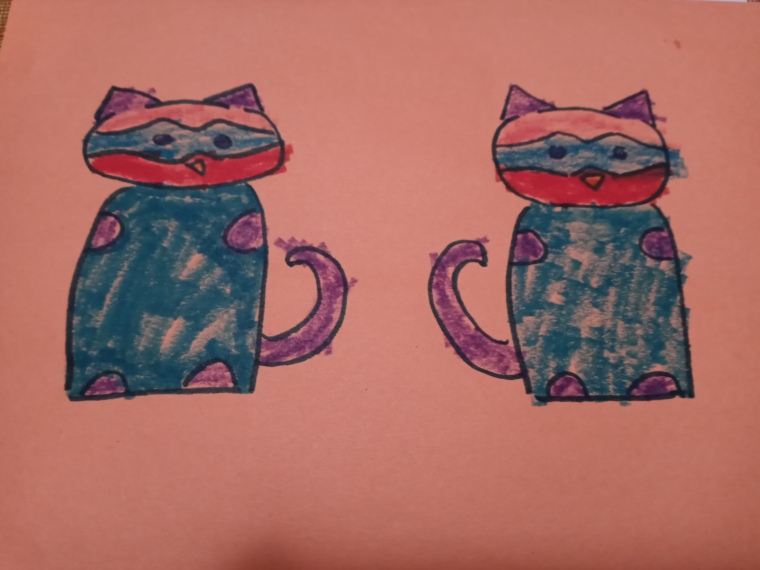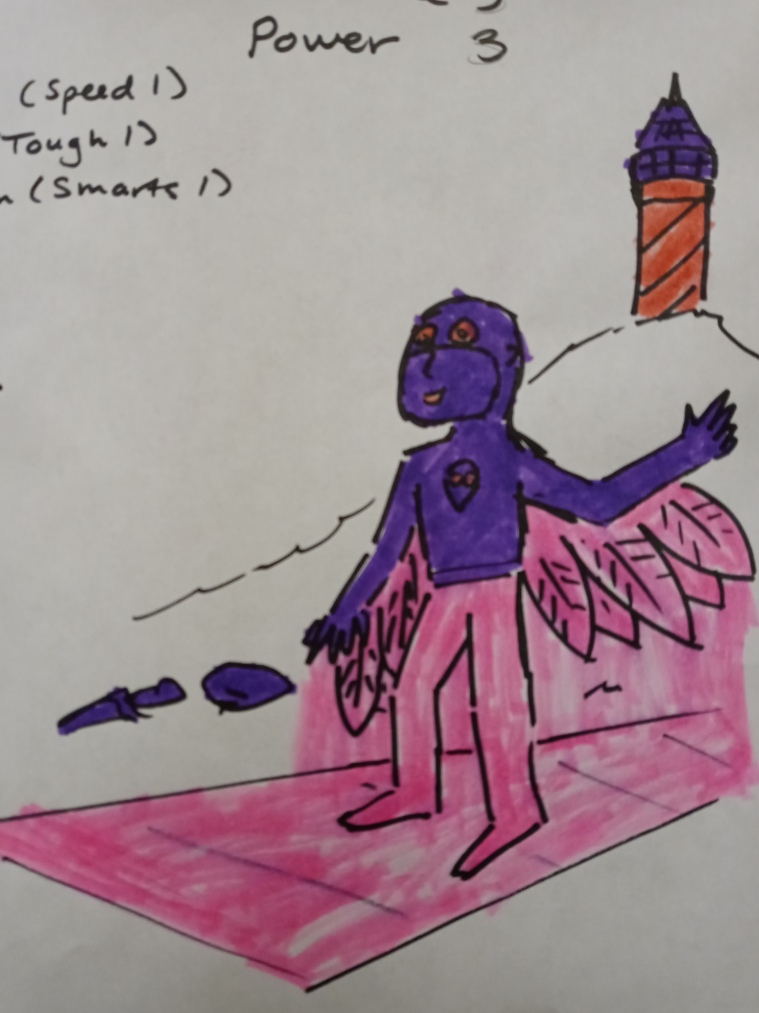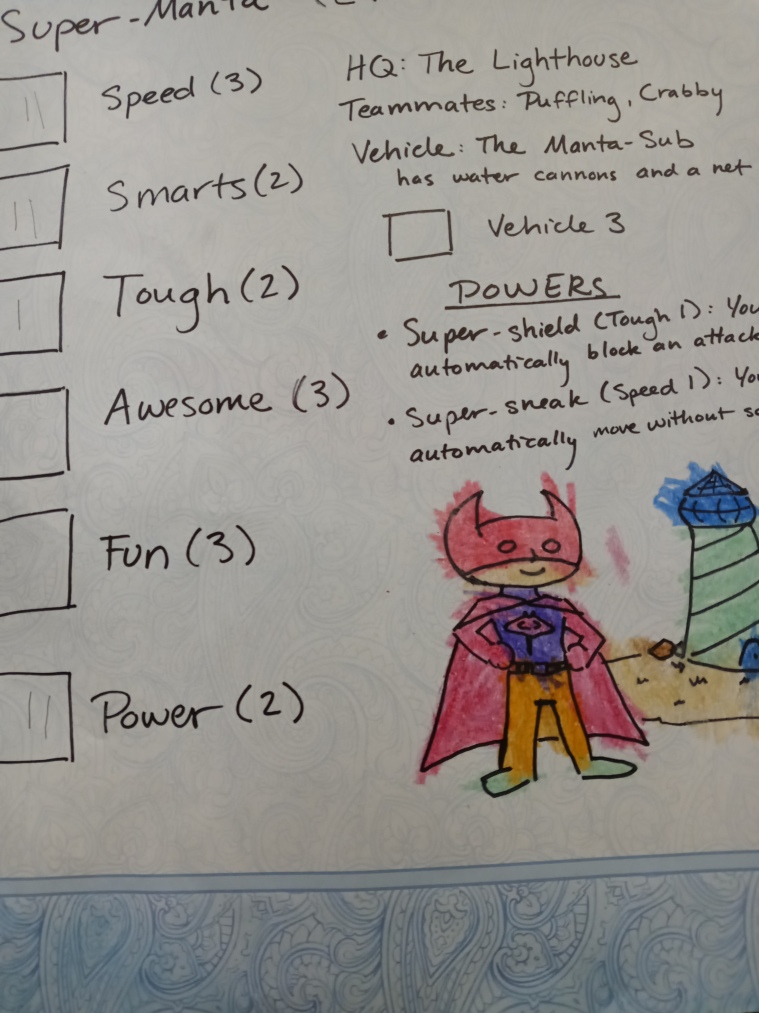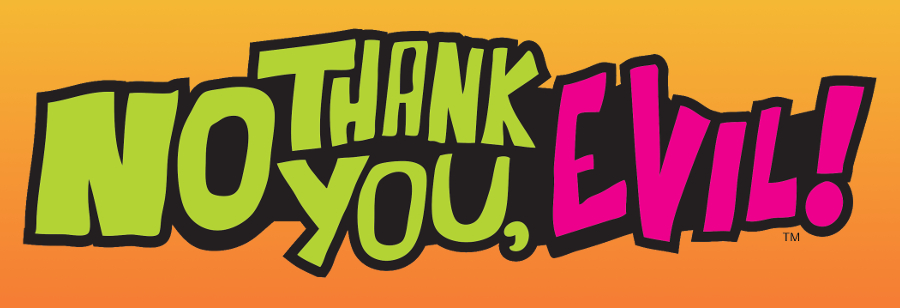Superheroes are big right now and that is true for kids as well as adults. My little gamers-in-training are obsessed with some kids superhero shows and I decided to lean into it by adapting No Thank You, Evil! for the purpose.
Thanks to Joe Thomas on the NYTE Facebook group for some great suggestions on improvements to the system. Updates below!
The Little Mephling and Grue are both fans of a certain kids superhero show that will remain nameless. If you’re a parent you likely have run into it as well but if you aren’t clear then I’ll just say that it rhymes with PJ Tasks. This is not (necessarily) a game for playing that show but it draws a lot of inspiration from that show because… well if you can’t beat ‘em, then join ‘em.
The basic idea, similar to the characters of No Thank You, Evil! is that kids play kid characters (maybe even themselves) who have adventures at night time when everyone is sleeping in the real world. The characters in this story aren’t headed to Storia, though, they are headed out into “the City” to take on villains who are up to no good while the adults all sleep. The only thing standing in their way are superpowered heroes who work together and learn lessons while they fight crime.
Welcome to Bedtime Heroes!

Persona
When kids turn into heroes at bedtime, they take on a new persona. They’re still the same kid but they now have a new hero name, a costume, and (importantly) superpowers. It can be hard to come up with a new superhero but Bedtime Heroes draws inspiration from the source material to encourage superhero personas themed around animals. There’s a lot of recommend this approach since animal themes are both immediately relatable (there’s no question what a tiger’s powers are or an octopus’s) but they also don’t have a lot of emotional or cultural baggage.
Below is a partial list of animal themes, but kids can also pick their favorite animal. It has no direct effect on their game numbers so inventing your own animal is as simple as announcing your choice. If you’re struggling for an animal idea, though, you can use this table by rolling two six-sided dice. Read the results separately (don’t add) and consult the table. For instance, if you rolled a 5 and a 3 you’d look down the table and see that your result is “turtle!”
| Roll | Animal | Roll | Animal |
| 1,1 | Penguin | 3,3 | Monkey |
| 1,2 | Moth/Butterfly | 3,4 | Manta |
| 1,3 | Buffalo | 3,5 | Turtle |
| 1,4 | Dolphin | 3,6 | Tiger |
| 1,5 | Alligator/Crocodile | 4,4 | Bat |
| 1,6 | Salamander | 4,5 | Shark |
| 2,2 | Hawk/Eagle | 4,6 | Bear |
| 2,3 | Spider | 5,5 | Puffin |
| 2,4 | Frog | 5,6 | Coyote/Wolf |
| 2,5 | Snake | 6,6 | Parrot |
| 2,6 | Jaguar |
You also need a name for your hero based on their persona. Sometimes you strike gold with something that sounds really awesome (hard to beat a name like Champion for a dog-themeed hero, for example) but if you’re stuck here are three approaches that I think work out pretty well for the kids superhero genre. First, try adding “girl,” “boy,” or “kid” to the end of the animal name (Frog-boy, Snake-girl, and Bat-kid are winners) which works better for short animal names. Secondly, try thinking of a particular species of that animal type and call them that (Rockhopper for a penguin-themed hero or Cobra for a snake-themed one would be great). Lastly, think of what the young of that animal are called and see how that sounds (Tadpole, Wolf Cub, or Caterpillar all sound cool).
Abilities
Unlike in your standard No Thank You, Evil! game, I think the best approach for making character abilities in Bedtime Heroes is through a lifepath method. This is a roleplaying game term for “making up the numbers while you make up the story. Heroes have Speed, Smarts, Tough, Fun, and Awesome like other No Thank You, Evil! characters, but they also have a stat called Power which lets them do superpowered craziness. Because of this new pool, you skip the Adjective and Verb parts of character creation from No Thank You, Evil!
Awesome, Fun, and Power start at 3, the other pools (Speed, Smarts, and Tough) all start at 1 and are added to by answering the following questions. This also determines what type of defense you have too.
- When an enemy runs at you, do you dodge or block? If you said “dodge” then write down Hustle as your defense. If you said “block” then write down Armor.
- When there’s danger, do you rush to help or plan first? If you said “rush to help” add +1 Speed. If you said “plan first” add +1 Smarts.
- When you’re trapped, do you bust free or spot a clever escape? If you said “bust free” add +1 Tough. If you said “clever escape” add +1 Smarts.
- Is your persona an animal that’s big, fast, or careful? It can be more than one of these, but which do you think is the coolest feature? If you said “big” add +1 Tough. If you said “fast” add +1 Speed. If you said “careful” add +1 Smarts.
- When a heavy door is closing do you rush underneath to get to the controls or hold it open for your friends to get through? If you said “rush underneath” add +1 Speed. If you said “hold it open” add +1 Tough.
And you’re done! You’ll have a set of pools after this and they are similar to the pools for the nounts in No Thank You, Evil! You might even have the same stat pools as one of the other heroes! This one is all yours, though, and the answers tell you as much about how to play your character as they do about the numbers.
The Power Pool

Spending a point of Power lets you roll an extra Power Die for your roll so two dice total. This means instead of getting a result between 1 and 6 you can get a result between 2 and 12 with a Power Die roll! Probably, though, you’ll get something around 7.
You should only do this when you are doing something that involves your superpower, like a superspeed character catching a villain or a superstrong character opening a door. Because a Power Die can roll as high as 10 you can do things that no ordinary person could do, even an adult! That’s why they call you a superhero.
It’s Time To Be a Hero: When you fail at something, it’s just fine! You don’t have to succeed all the time to be heroic but when things don’t go your way then that’s the time to learn from your mistakes and try again harder. When you roll a 1 on a roll (even a roll with a Power Die) then you get a point of Power back in your pool.
Superpowers
What’s a superhero without superpowers? Well, still a “hero,” I guess, but they’re still important. You can pick out powers from this list or roll to see what powers you might have. Characters should roll or choose three superpowers from this table for their character. This will be a roll of two d6 dice, just like the animal persona.
| Roll | Superpower |
| 1,1 | Super-sense (Smart 1): You can see and hear really far distances. |
| 1,2 | Super-speed (Speed 1): You can zip to anywhere in the scene in a second. |
| 1,3 | Super-strength (Tough 1): You lift, pull, or bend anything. |
| 1,4 | Super-hide(Smart 1): You hide somehow so that no one can see you. |
| 1,5 | Super-snatch (Speed 1): You grab something away from someone else. |
| 1,6 | Super-push (Tough 1): You push the enemy with wind, a roar, etc. |
| 2,2 | Super-escape (Smart 1): You wriggle free of anything. |
| 2,3 | Super-climb (Speed 1): You climb up anything. |
| 2,4 | Super-shield (Tough 1): You block any attack coming at you, avoiding all harm. |
| 2,5 | Super-build (Smart 1): You make something really fast. What’s the thing you build? |
| 2,6 | Super-trap (Speed 1): You trap the villains before they know what’s happening! |
| 3,3 | Super-fling (Tough 1): You throw something far away, maybe even a villain. |
| 3,4 | Super-fool (Smart 1): You change to look like someone else. |
| 3,5 | Super-wings (Speed 1): You fly higher, faster, or better than someone else. |
| 3,6 | Super-shell (Tough 1): You crash through anything that can be broken. |
| 4,4 | Super-bag (Smart 1): You have a bag of stuff and pull out just the right tool. |
| 4,5 | Super-sneak (Speed 1): You move without a sound. |
| 4,6 | Super-cool (Tough 1): You are comfortable in all the hottest places. |
| 5,5 | Super-program (Smart 1): You make a computer do whatever you like. |
| 5,6 | Super-morph (Speed 1): You flatten out and fit through cracks. |
| 6,6 | Super-warm (Tough 1): You are comfortable in all the coldest places. |
Super Powers and Power Points
So what’s the difference between the superpower abilities in the table above and the Power Points in your pool? In the story, nothing. You have superpowers and sometimes you spend a point from a pool as listed above and sometimes you spend a Power Point.
For the game, though, spending points as listed above is better because you automatically succeed. It’s your special ability in action, your superpower lets you do things that are amazing and you just do your thing. Power Points give you a bigger die but you still have to roll so you might not do it. As a strategy, you should spend your Power Points whenever you need to do something superpowered but if it’s something that is really, really important to succeed at then you can spend points from your other pools to automatically do your thing.
Sometimes you also want to do something that’s related to your superpower but isn’t exactly what is listed above. You might have a sticky tongue that lets you super-snatch but you want to use it to hit the control panel and open a door. That’s not what the automatic power is so you’d need to use a Power Point for it. As another example, you might want to use super-climb sticky pads to hold onto a racing train or super-morph to hide as a blanket, both of which are not the automatic power and so you would use a Power Point or just roll normally.
Vehicles

Heroes also have vehicles that they can use. This might be a car, a plane, or a submarine and it’s stored in your home base until you need it. You can’t use your Speed, Smarts, or Tough points while you’re in your vehicle, you’ll need to jump out of it to use those pools. The vehicle itself, though, has its own pool of Vehicle Points which can apply to anything you do with the vehicle including driving it, using its devices, or chasing fleeing villains. Vehicles have 3 points in their Vehicle pool.
Cars can go very fast, planes can fly, and submarines can go underwater (and usually drive slowly on land). In addition, your vehicle has one special ability that should be themed to match your persona. Pick an ability or roll a die to determine one randomly.
- Armored: Your vehicle is tough and hard to damage.
- Cannon: Your vehicle throws or launches something.
- Detector: Your vehicle has scanners to find information and dangers.
- Stealth: Your vehicle is very sneaky and hard to see.
- Strong: Your vehicle can lift and pull heavy loads.
- Zippy: Your vehicle is fast and maneuverable, making quick turns and tricks.
Sample Heroes
Here are two heroes that Little Mephling and I made for our home game. Feel free to have them cameo in yours!
Super-manta
Base: The Lighthouse, Bay City
Vehicle: The Manta-Sub (throws things, water cannons and a net), Vehicle 3
Speed 3 | Smarts 2 | Tough 2 | Awesome 3 | Fun 3 | Power 3 | Defense Armor
Super-shield (Tough 1), a superstrong cape of manta wings.
Super-sneak (Speed 1), silently moving like a manta ray.
Super-speed (Speed 1), like a hunting manta!
Puffling
Base: The Lighthouse, Bay City
Vehicle: Puffin-copter (detector, scans the ground for villains), Vehicle 3
Speed 3 | Smarts 3 | Tough 1 | Awesome 3 | Fun 3 | Power 3 | Defense Hustle
Super-program (Smarts 1), a computer whizz.
Super-push (Tough 1), wind from powerful wings.
Super-wings (Speed 1), the fastest flyer in Bay City.


This is awesome! So well done and really hits the right points for character generation and depth. Great way to start a new gaming tradition with the kids!
LikeLike
Thanks! I’m especially proud of villains so check that out when it’s posted soon…
LikeLike